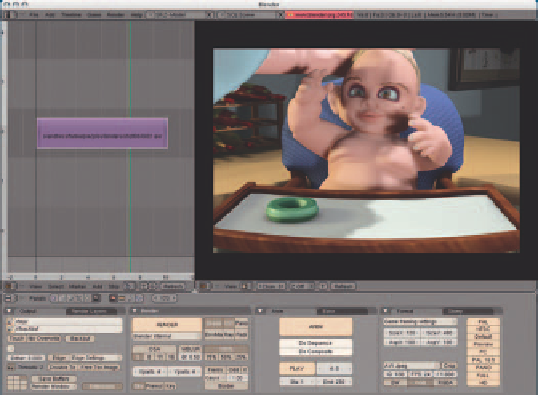Graphics Reference
In-Depth Information
Checking the Final Frames
When each computer in your render
farm has delivered at least one frame,
you should check a sample from each
one to make sure that things are work-
ing properly. Because you've been eat-
ing, drinking, and sleeping Blender for
the past many weeks or months, it makes
sense to open and check the OpenEXR
frames within one of Blender's image edi-
tor windows. If you're on Linux, you can
try CinePaint as well. The easiest way
to do this in Blender is to add the ren-
dered frames to a Sequencer window as
an Image Sequence. Then you can split
off a Sequencer preview window and
scrub over the timeline to view the frames. Figure 15.72 shows the setup. The nice thing about using the
Sequencer in this fashion is that you can simply use the
Do Sequence
button in the
Scene buttons
, set a
frame range and appropriate output format, and export the frames as a full animation with the
Anim
button.
Figure 15.72
The Sequence Editor used as a frame viewer
If you are reviewing all of the frames for a particular shot, be sure to check them over carefully. The next
time you see them will be during editing when you are concentrating on things such as syncing the per-shot
sound fi les to the fi nal edit and creating transitions and cuts. It's better to fi nd a problem, fi x it, and send it
back for a rerender right away than when you've mentally moved on to other things.
Finally, if you see something bad that appears in just one or two frames, like a hair that goes wild or a black or white
dot compositing artifact, remember that Blender's Image Editor is exactly that: an editor. Although the paint tools
are limited, as we learned in Chapter 4, they still may be good enough to touch up a few rendering mistakes.
Staying Organized
When you reach this stage of production, you will have a lot to think about and even more to keep track of.
A simple spreadsheet, either made in the decreasingly ubiquitous Microsoft Excel or any of the free alterna-
tives, such as OpenOffi ce.org or Google's Google Docs, will work. Figure 15.73 shows the spreadsheet that
was used to track fi nal production of
The Beast
. The columns are:
●
Final lighting
●
Composite built and checked
●
Final animation testing
●
Farm render check
●
Rendering
●
Final renders checked

Search WWH ::

Custom Search